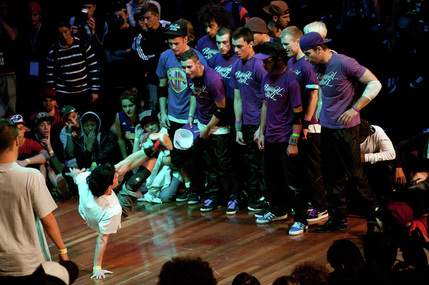 Breaking crew battle @ IBE 2010 Last week's Who Iz Underground took over a small alcove in a deserted section of a train station in Paris. This past weekend's Notorious IBE (International Breakdance Event) took over an entire town in Holland! It was B-boy city in the Netherlands as the IBE had set up shop in 8 different venues all over the small city of Heerlen for the whole weekend. (Although that entire Saturday I thought we were in Rotterdam until a Dutch friend kindly informed me otherwise. "Wait, what do you mean we're not in Rotterdam??") From an open air venue in the town square to their major concert hall to their local university to every other multipurpose space available, the IBE had completely taken over.
Heerlen had clearly embraced the huge international event which boasted over 2,500 b-boys and b-girls from 30 different countries (mostly European). The mayor of the town officially welcomed the IBE-ers at the opening ceremony. Locals integrated into the crowds and watched cheerfully. TV news crews covered the spectacle (and interviewed yours truly!). And there is no question, that like any other industry convention, the IBE was a boon for local businesses and the local economy, which is good news for this struggling city that l ost 60,000 jobs when coal mines were closed several decades ago. I arrived Saturday afternoon following a four-hour cramped car ride at the back of a VW Golf with four other dancers from Paris. We left from Porte de la Chapelle at 9am where throngs of other Paris dancers were boarding buses all headed for Heerlen. It was mass exodus for the promised land of street dance culture (at least for that weekend). A Senegalese-French popper I met at Who Iz Underground had invited me along for the excursion. With us in the car was a b-boy, a Hip Hop dancer, and another popper, all of whom were of African or Arabic ethnicity. We went on to meet up with other French dancers at IBE from Paris and Lille, few of whom I would guess were ethnically French.  The main venue on Saturday @ IBE 2010 While the French street dance scene is comprised mainly of those from immigrant communities, this did not seem to be the case for the busloads that arrived from the UK, Italy, Portugal, Scandinavia, the Netherlands, which tended to be more mixed or just predominately white. Hip Hop culture in every country and every city takes root in different ways, varying according to who is growing that particular scene. Even in the US, the traditional Hip Hop dances like breaking and popping are practiced by Latinos, Asians, and whites. In contrast, the newer Hip Hop dances like Flexing and Jerkin' are predominately practiced by Black youth. Out of all the Parisian dancers I met, only one was living off the culture as a professional dancer. In the mix were also: - an air conditioner repairman
- a computer engineer
- an airport worker (unclear as what exactly)
- a theater director
- a marketing manager for a major pharmaceutical company (Which one? Hint: they make a drug for erectile dysfunction.)
- a college student
For the most part, English language ability correlated with occupational status, except in the case of the professional dancer who actually spoke English the best. Ironically though, he had gone to college to study international business. Walking down the street, based on our baggy jeans and the color of our skin, it would be easy to assume that we were ghetto youth when in actuality, we defied any single socio-economic class, any single level of education, any single ethnicity. We were as diverse as the Hip Hop culture we embraced. Hooray for the subversion of prejudice and unity through diversity!
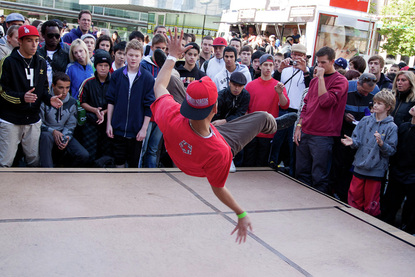 Breaking in the Heerlen town square Language and Unity As the professional dancer told me in his British-accented English: "Big events like these are really great 'cuz they bring people together, and just because we don't speak the same language, we still communicate to each other through dance." Despite this heart-warming account of a boundary-less Hip Hop-unified world, I could still sense the nationalist pride underscoring the event. Dancers repped where they were from to the fullest. They waved flags and debated which country had the strongest talent, which country was on top. And to me it seemed that France was. Whether in the breaking, popping, locking, Hip Hop, or house battles, their presence was felt. But even within the French contingent was a huge dividing line between Paris and Lille. The cities clashed on the dancefloor, with respect and admiration yes, but with bitter rivalry as well. It was like the South Bronx feuding with Queens. In the end though, it hardly mattered. Everyone gave pounds and exchanged hugs, expressing their eagerness for the next city and next event they would see each other at. As our driver, the computer engineer explained to me: "I don't really go out to clubs or anything. I just practice during the week and travel almost every weekend to battle." This is street dance life.
Coverage of Day 3 of the IBE from IBE TV:
 After the 2010 Techno Parade of 30,000 people ( or 300,000, depending on your stat source) danced through the streets of Paris Saturday, the interweb is brimming with two different narratives of the event: - The Techno Parade was crazy, fun, and full of good humor!- The Techno Parade was hijacked by hooded thugs causing trouble! (This narrative clearly embedded with racist undertones) The AFP (Agence France-Presse) described the event: "Techno Parade inaugurated its new version on Saturday in the streets of Paris, on the occasion of its 12th edition, during which the audience danced to the sound of techno music in a relaxed festive and colorful." (Please excuse the awkwardness of this Google translation.)
Additionally the AFP states that the police reported no incidents at the event. Here's video coverage of the parade from another newspaper Le Parisien: In stark contrast, Le Figaro's article ( Le Figaro being the oldest French newspaper) titled "38 arrests at the Techno Parade in Paris" focuses on the police's handling of "troublemakers" from red light districts of the suburbs: "Groups of thugs were attacking passersby, yelling at each office to intimidate them. But hardly these aggressive packs were beginning to break up the police trap was closing in on them. In small groups, the thugs were promptly driven in buses to join the local police headquarters…" Moreover, the article cites blog videos that "show real hooded hordes of people, including many teenagers of African origin, intimidating passers-by…" The article most likely refers to this video, produced by Projet Apache, that portrays "Violence at the Techno Parade" at the hands of black youth. Projet Apache is clearly an uber-conservative, French nativist blog that engages in the age-old conservative practice of fear-mongering, calling the youth "thugs" that attack anyone who is a little "too white." Like conservatives in the US who have appropriated and flipped the language of Civil Rights activists, this blog claims that anti-white racism is rampant and needs to be brought to an end. 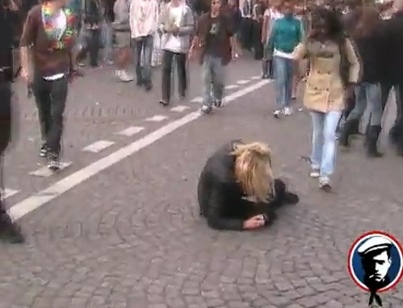 Out of context, it's unclear what this image represents, same as the video above. A commenter on Le Figaro, who cites Projet Apache, warns of what will happen when these gangs or hordes of thugs become organized. He fears that one day they will loot Paris from top to bottom. The seeds of hate clearly well sown here in Paris. Thankfully online magazines Musique Mag and Agora Vox (a citizen journalism driven site) are calling Le Figaro out on its racist coverage of the parade. However, the online poll attached to the latter article indicates that 70% of readers "agree" with the video depicting the violence. I'm not sure if that means they agree that violence was a huge problem or that they agree that the coverage is biased. Unfortunately I wasn't at the parade to witness everything with my own eyes, but judging from these pictures and knowing how media tends to sensationalize what goes on at large youth gatherings, I'm going to say that for the most part, despite a few probelmatic incidents, overall this event was probably good times across a diversity of people. It set out to bring people together in a fun, festive way, and in that regard it seems to have succeeded.
If you are in Paris tomorrow, you must get your dance on at the Techno Parade: 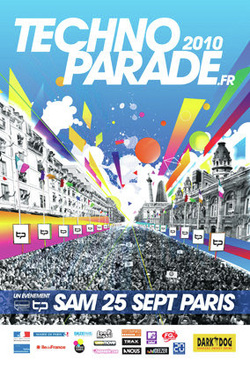 What better way to spend a Saturday then to take over the streets of Paris via a roving techno dance party. Here's the info:"For its 12th edition Techno Parade will start at 12pm Place Denfert-Rochereau, then take the avenue Denfert-Rochereau, St Michel Boulevard before turning on the Boulevard Saint Germain, crossing the Seine on the Pont de Sully to complete the Place de la Bastille."Sadly I will be in Rotterdam for another major street dance competition with a group of Parisian dancers (more on that later), so please dance dans le rue on my behalf.
On Sunday I travelled to La Defense, the major business district of Paris located at its Western border. Though architecturally fascinating since the district's glass and steel skyscrapers sharply contrast with the rest of neoclassical Paris, I was not there to stare up into the sky at huge buildings. I was interested in what was below them. I had found out several days prior that a small street dance competition would be taking place at La Defense train station. I came across this intel while on Facebook researching another street dance competition, Who Iz Who?, a massive battle taking place in Paris in two weeks. Organizers expect over 4,000 street dancers from all over Europe to converge on the City of Lights for their chance to shine. A smaller battle, Who Iz Underground, would take place at La Defense in anticipation of this main event. When I arrived at the station, as usual, I had no idea where to find the scene. I wandered all over the massive station and above it for nearly an hour, seeking some hint of Hip Hop. The Facebook announcement for the event simply said La Defense; clearly this was a rendezvous for insiders. I finally came across a pair of athletically-built teens, suited up in slim fit jeans, Pumas with fat laces, and fitted caps, backpacks slung over their shoulders. They seemed to be b-boys (or breakdancers), so as is routine for me at this point, I followed them. They walked down an empty corridor, passing rows of closed shops and boarded up walls from ongoing construction, Slowly, however, there began to be more youth along the way, lacing up and stretching out--an auspicious sign. I followed them around a corner, and I was greeted by a sight to behold: a dense mass of Hip Hop kids crowded into a tight recess of the station and completely engrossed by the dancers at the center of the cypher. I have never experienced anything quite like it. I've been to street dance competitions all over the U.S., Japan, Germany, and Sweden that take place in concert venues, clubs, gymnasiums, and even churches. These events often charge entry and are formally organized with fiscal sponsors and everything, much like concerts, but this was something different. This was more like a flash mob, a takeover of semi-public/semi-private space, where the 100 or so people merely assembled at the given time and used the available space to carry out a cultural ritual with or without permits. There was no money exchanging hands, no sponsors or banners, no spectators or tourists, no seats. There wasn't even a DJ with turntables. Instead, a man at the center of the crowd scrolled through his iPhone playlist and blasted beats through a guitar amp. It all felt very improvised, very Hip Hop. I wouldn't have been surprised to see that amp jury rigged to some cables and stealing electricity from a streetlight. This guerrilla-style attitude manifested itself into the intensity of the crowd as everyone there watched with bated breath, ready to erupt for every bold new move, every athletic display of creativity. The energy was electric. They also didn't seem to notice or simply didn't care when alarms went off every time someone got too close to the closed shops at this end of the station. At the same time though, the police never showed up either, and so the competition continued unbeknownst to the tourists above ground and the travelers passing through the station. I was later told that like Les Halles, street dancers congregate at this far end of La Defense every other night of the week after all the businesses close. They use storefront windows as mirrors, creating makeshift studios at every stall. The dancers are peaceful and so are hardly ever dispersed by the police or business owners. The battle going on Sunday simply manifested what has already been going on there for years. That night, one-on-one tournament-style competitions took place in three street dance styles: popping, house, and what they called "new style" (contemporary Hip Hop dance). The winners of each competition, all of whom I perceived to be of Arabic ethnicity including at least one Mohamed, received a ticket to the Who Iz Who? main event in two weeks which is worth about 20 euros. The dancers competed, then, mainly for bragging rights and for the love of dance. The event itself obviously did not produce any profit and served only as an outlet for cultural expression. Ironically, all this transpired right beneath the financial district of La Defense, where a wellspring of community continues to thrive underground.
On a sunny Saturday afternoon, I embarked on my first journey to the outskirts of Paris to find Paris skate culture. I arrived at station Saint-Denis Universite after a painfully long trek on Metro line 13 all the way to the end of the line. Foolishly I forgot to bring a map and I wandered the streets surrounding the station for some time until finally I heard the traces of booming bass echoing through the trees of this quaint suburb. On top of the bass was the unmistakable vocal hype of a live announcer, commenting on the action at hand. I followed the amplified noise until it led me to a clearing of concrete, where packs of young boys sailed across rails and sped up ramps in the urban equivalent of a jungle gym. This was Skate Roots Contest 3. Not only was this my first skateboard event in Paris, this was also my first skateboard event in life. My only previous exposure to skate culture has been through the ESPN broadcasts of the X-games and countless hours wasted on Tony Hawk Pro Skater on PlayStation 2. Needless to say, this X-perience was X-tremely different (apologies for the pun, I couldn't help myself). Instead of an alternative rock, white counterculture that I've come to associate with skating, I found a distinctly diverse crowd, clearly immigrant heavy and working class, kick/pushing along to the sound and style of Hip Hop. Every single track pouring through the speakers was (American) rap. A local French rap group even kicked off the event with a performance. And while these young boys, ranging anywhere from 7 to 27, ollied and grinded in the afternoon sun, their immigrant parents--dressed in saris, hijabs, and dashikis--and adoring female fans looked on in admiration. Not to say this was a fan-frenzied ESPN-style event. It was quite the opposite. It was a community gathering for local kids where families strolling through the park could stop and enjoy. It was an environment wear a boy no higher than my waste could happily skate along with boarders twice his size and age as they competed for the 100 euro prize. But it did seem that the cash prize was less an incentive than was the love to skate with one's peers, one's community. All that was missing was a barbecue. They did have baguette sandwiches however. 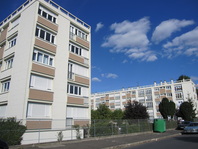 Adjacent to the skate park stood gleaming white apartment buildings, which are most probably, judging by their size, location and inhabitants, subsidized housing projects. Their towering presence underscored the significance of this small skateboarding event. This is because in 2005, these immigrant suburbs along with countless others throughout France were set ablaze with youth revolt, provoked by persistent institutional racism, joblessness, and police harassment. [ Insightful NY Times article about all this]
Saint Denis, the name of this Paris suburb, was known for being one of the largest industrial areas in Europe until the economic crisis of the 70's and 80's forced upon it devastating deindustrialization, akin to the blight that afflicted many American cities like Detroit and LA around the same time. It was during this period that cheap affordable housing gave way to an influx of immigrants. Today, Saint Denis is home to the Stade de France as well as several service industries, but the lack of jobs is still a major problem as unemployment has risen to 21%. However, since the unrest of 2005, it seems that there has been an effort to move towards reconciliation and development. In 2006, the mayor along with leftist political leaders led a campaign to obtain voting rights for non-EU foreigners in local elections. Though the measure was ultimately deemed illegal, it demonstrates a willingness to integrate the immigrant community. In 2007, the Saint Denis Skate Plaza opened. Just 10 minutes from their downtown, this 1,500 square-meter skate park is one of the largest in Ile-de-France. It was supported by a budget of €465,000 from the city government and created in much consultation with local skaters and residents. Public support for youth culture certainly goes far in quelling social unrest. This small skateboard contest then was a testament to ongoing efforts improve conditions in this troubled suburb. It was the third contest in the 3 years since the park opened, hosted by Skate Roots Association of Saint Denis, a local skateboarding organization that also hosted the official opening of the skate park. Indeed, I could see the collaboration between local community and city government when a late middle-aged man dressed in full gray suit walked through the event midafternoon, shaking hands with organizers and looking pleased by the competitors. It's probable that he is one of the city officials responsible for the skate park. As the day wore on and the sun set, the skateboarders continued, unphased by both the drop in temperature and their accumulation of cuts and bruises from missed tricks. They were focused completely on their craft, their street culture. Hour after hour, while onlookers left, they continued at peace with their concrete home. Scrawled on one of the ramps in Sharpie was a tag that read "Ghetto Requiem."
I found this little flyer while perusing a skate shop in the 7th arrondissement earlier this week. It looks to be a small event, but I'm excited to see who shows up. Maybe there'll even be some Parkour! I'm also looking forward to checking out this "Skate Plaza" in a neighborhood I have yet to visit, very much away form the center of town (it's the end of the metro line). And apparently there's a quite a few open Skate Plazas in Paris. Hopefully this will be the first of many that I visit.
 While waiting to meet up with a friend outside the Chatelet train station near the center of Paris, my eyes widened when a young couple walked by dressed in the freshest Hip Hop gear. While usually such a sighting is unremarkable in an urban setting, these two caught my attention because their bright purple and black outfits matched, from their baggy sweats to their fitted caps. The untrained eye might mistake them for a gang, but I could clearly recognize them as street dancers. I watched as they hurried off, and out of curiousity, began following them, hoping they might lead me to a dance performance. They turned a quick corner into an open square, but I wasn't as quick. I lost them. Looking around for signs of bright purple, I scanned the urban landscape for the couple to no avail. But just when I was ready to turn around and leave, I saw rapid movement coming from the balcony of Forum des Halles. Street dancers!
I climbed the stairs to the balcony where I found several groups of young Hip Hop kids dancing in front of the glass of the building's exterior. Just as I'd seen in Tokyo a few years ago, these street dancers practiced their craft using the architecture of city as their dance studio. The glass walls provided mirrors while the balcony provided open floor space. Each group of dancers claimed their individual part of the "studio" where they had hooked up iPods and PSPs to portable speakers. Emboldened by the discovery, I approached one pocket of youth, introducing myself in broken French: "J'habite en New York. Je suis danser...ehh...Foto?" Luckily a couple of the teens spoke more English than I speak French. They were delighted by the request and immediately formed an impromptu cypher to demonstrate their skills, eager to get on camera. They turned up the music (which on portable iPod speakers is about as loud as a walkie talkie) and got down. In their skinny jeans, bright tees, and fat sneakers, they danced one by one to contemporary, minimalist hip hop, doing some heel-toe steps, dropping down to the floor, and grooving back up. The others clapped and cheered as each got in their solo. I asked the ambassador of the group Frank if the dance style they were doing was Get Lite, a dance I'd seen from Harlem. "No, Get Lite is dead," Frank enlightened me. "The last video on Youtube was from 2008. This is Jerkin' from LA." I'd never heard of Jerkin'. Here I was, an American from NYC, the cultural capital of the world, and had no clue what this new American-made dance was. I needed these young folks who have probably never even been to LA to inform me. Wikipedia confirms that Jerkin' started around 2008 in LA, made popular by a song by the New Boyz called "You're a Jerk." Curiously enough, the article likens the dance to that of the French dance called Techtonik. More on this other dance later.
Here I was, documenting this dance, amazed at how it travelled to these youth a continent away, and through this vehicle they found a community, a culture, and a lifestyle. It was a diverse group of youth, composed of different races, ranging in age from 17 to 11. Though they were mostly young boys, there was one female in the group who seemed to be regarded as an equal in this dance. I assumed they were all friends or classmates from the same immigrant neighborhood in Paris, but again I was mistaken. They actually came from all different parts of the city, but generally all from the border. Frank said they found each other through Facebook, and they gather at Chatelet every Sunday to practice. Indeed there is a whole Facebook community of young teenage Jerks in France, with over 3,600 fans. Here they update each other on the latest music, fashion, and dance moves within the culture. They post videos of themselves battling and boast about their respective crews. Judging by the pictures and video, they are emulating the New Boyz to the T. I haven't been able to locate Frank or others on Facebook yet, but I'll definitely be back at Chatelet to learn more.
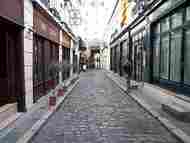 "Dans La Rue" is French for "On The Street." This blog sets out to document and explore what is going on the streets of Paris, namely cultural expression from the city's urban youth. Part travel journal, part ethnographic study, I seek to uncover parts of the city and it's exurbs that most tourists overlook and discuss the ways in which Paris' diverse young people create community and produce culture. Instead of the Eiffel Tower, I'll look at who's dancing in front of it and how they got there. Instead of the best places to eat pastries, I'll find the best places to skateboard and show who goes there.
Ideally, this will provide a launchpad to also jump into an array of related topics. How do things like race, gender, immigration, and class play into these street cultures? How are such cultures perceived by the rest of Paris? How are they perceived by the police? What are the laws in place enabling or hindering youth from congregating? What does globalization have to do with any of this? What does it mean for practitioners to reclaim public space?
As an outsider from the U.S. with almost no French-speaking ability (I can order quiche at a boulangerie, but that's about it), it will certainly be a challenge for me to immerse myself in these underground cultures. However, that process will be part of the story. For now I will rely on what I know as an outsider and focus on four areas that I'm certain are developing here in Paris:  Street Dance: Often considered the umbrella of Hip Hop dance, this includes breaking, popping, locking, house, Hip Hop, vogueing, wacking, etc. This is the scene I am most connected to personally and will probably have the easiest time finding.
 Street Art: Also associated with Hip Hop, street art emerges as an outgrowth of graffiti culture and has come to incorporate murals, posters, stickers, installations, wheatpastes, urban sculptures, etc. The most well-known Parisian street artist at least in the U.S. is Space Invader, who played a prominent role in notorious street artist Bansky's documentary film Exit Through the Gift Shop. It should be fun tracking down this scene and its practitioners because it's illegal!...Then again, perhaps France treats it differently...
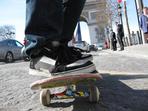 - Skateboarding: I will look for skateboarding in particular and more broadly, any form of extreme sports on wheels taking over public spaces. This culture is probably the least underground and should be relatively easy to find. I've already witnessed skateboarders getting harassed by Paris police after only being here for a week.
Parkour: As far as I can tell, it's the next evolution of extreme sports but this involves no skateboard or bike or any other apparatus besides one's own body. Essentially it is an acrobat's approach to engaging the urban landscape, much like the way Jackie Chan runs up a wall in his earlier films (pre: Owen Wilson days). Parkour is particularly exciting not only because it's severely dangerous but also because out of these four, it's the only practice that originated in France.
These should keep me busy for now, until I happen across other urban youth cultures. Since culture is fluid, I am sure I'll be able to ride the wave of one of these and soon find myself swimming in an ocean of cultural expression I never would have imagined. Like Jacques Cousteau, into the depths I go. Wish me "bonne chance." I think that means "good luck." Let's hope it turns out nothing like this:
|







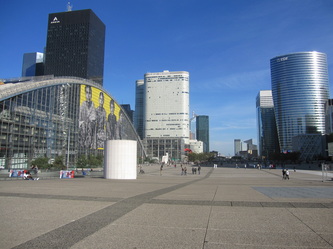


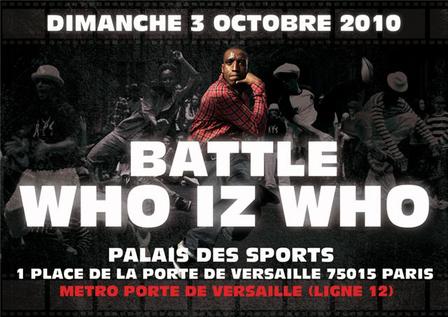

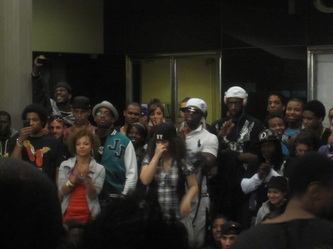
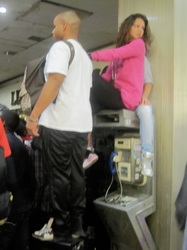
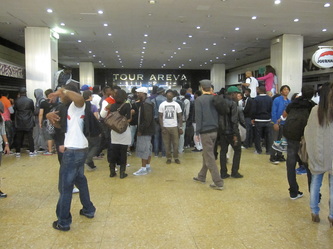
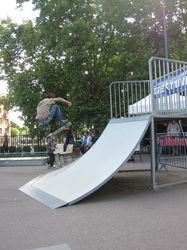
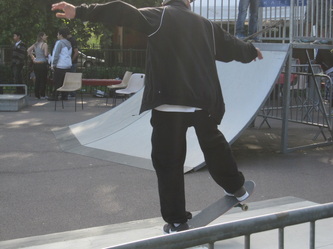


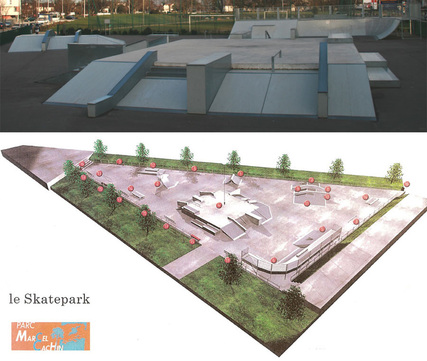
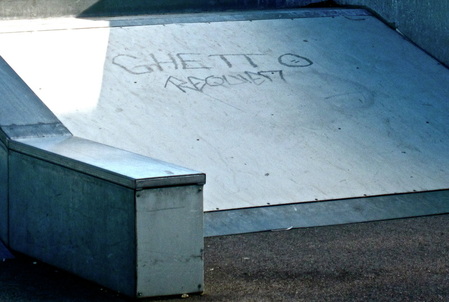
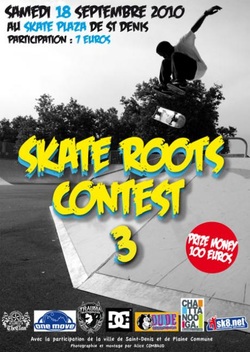





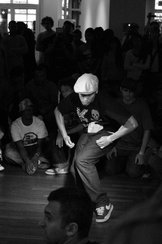
 RSS Feed
RSS Feed